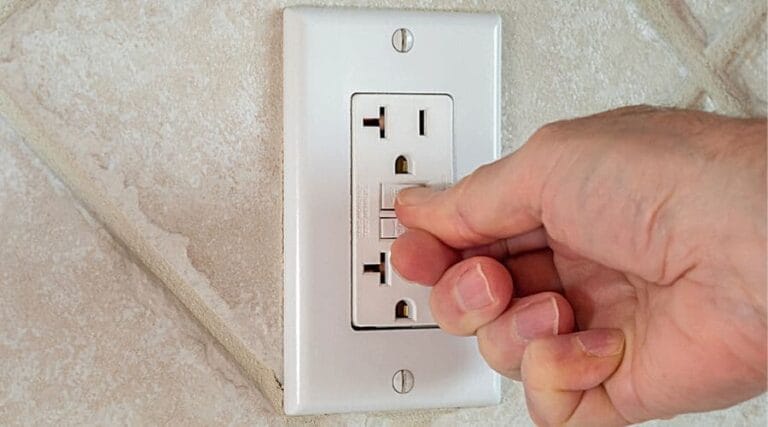Walk into any home built before the 1970s and chances are you’ll find at least a few of the, two-prong electrical outlets. They’re usually easy to spot. No round hole, just two vertical slots. Simple, outdated, and honestly, a little unsettling.
You’ve probably wondered: Are these still safe? Do I need to replace them?
It’s a fair question. Most people don’t think much about outlets until something goes wrong, a blown fuse, a fried laptop charger, or worse, an electrical shock. Two-prong outlets aren’t inherently dangerous, but they’re not built for the kind of electrical demands modern homes face.
Let’s walk through why these outlets still exist, what risks they carry, and what your best options are if you’re thinking of upgrading.
Table of Contents
What Are Two-Prong Outlets?
A two-prong outlet, also called an ungrounded outlet, has just two slots: one for the “hot” wire and one for the “neutral” wire. That’s it.
There’s no ground wire to direct stray electrical current safely away. That third hole you see on modern outlets? That’s what does the heavy lifting when it comes to preventing shocks and electrical fires.
Here’s a quick breakdown:
| Feature | Two-Prong Outlet | Three-Prong Outlet |
|---|---|---|
| Ground connection | ❌ No | ✅ Yes |
| Shock protection | Minimal | High |
| Safe for modern tech | Not recommended | Absolutely |
| NEC compliant | Only in limited cases | Yes |
In short: the third prong isn’t there for show, it’s there to protect you and your electronics.
Why Do Homes Still Have Two-Prong Outlets?
Older homes, especially those built before the 1960s, weren’t wired with grounding in mind. Back then, people didn’t have dozens of devices plugged in at once. There weren’t flat-screen TVs or gaming PCs to worry about. A lamp, maybe a toaster, and that was about it.
Fast forward to today: you’ve got chargers, speakers, laptops, smart thermostats, you name it, all pulling power from the wall. Those two-prong outlets just weren’t designed for that kind of load or complexity.
Some older homes have been partially upgraded, meaning you’ll find a mix of outlet types. But many still rely on those original two-prong setups.
And here’s the tricky part: unless you open up the wall, you won’t know if a ground wire is even present. That’s why an electrician’s inspection is often the first step in figuring out what to do.
Are Two-Prong Outlets Safe?
Let’s be honest, they’re not unsafe by default, but they don’t meet today’s safety expectations. And in some situations, they’re risky.
Here’s where they fall short:
- No grounding = no backup. If a short circuit occurs, there’s no path for the excess electricity. It could travel through you, or start a fire.
- Sensitive electronics can get damaged. Many devices expect a grounded power source. Without it, they’re more vulnerable to surges.
- Adapters give a false sense of security. Those little plastic converters? Unless your outlet box is properly grounded (and most aren’t), they’re doing nothing.
You might be thinking: But I’ve used them for years without issues. And that’s valid. But safety isn’t about what’s happened, it’s about what could happen. If there’s a 1-in-100 chance of something going wrong, do you want that moment to come while you’re holding a plugged-in appliance?
When Should You Upgrade?
If you’re using two-prong outlets today, the general advice is simple: start planning to upgrade. You don’t need to gut your home overnight, but the benefits of modernizing are real.
Upgrade if:
- You’re remodeling or opening walls anyway
- You plan to sell or rent out your home
- You regularly use expensive or sensitive electronics
- You’ve had surges, tripped breakers, or flickering lights
You might delay (for now) if:
- You rarely use the outlet
- It powers only low-risk items (like a lamp or clock)
- You’ve installed GFCI outlets as a temporary solution
But let’s be clear, GFCI is not a long-term replacement for proper grounding. It helps prevent shock but doesn’t protect your devices from surge damage.
What Are Your Upgrade Options?
So, what now? You’ve got a few paths depending on your budget, the condition of your wiring, and how long you plan to stay in your home.
Option 1: Full Rewire with Grounded Outlets
Best for: Long-term homeowners, full renovations
Pros: Brings your system up to code, adds resale value, provides complete protection
Cons: Higher upfront cost, may require opening walls
Ballpark Cost: $200–$500+ per outlet (depending on access and complexity)
This is the cleanest and safest route. If you’re doing a major renovation, this is a no-brainer.
Option 2: Install GFCI Outlets in Place of Two-Prong
Best for: Short-term fix or budget-conscious upgrade
Pros: Shock protection, relatively easy to install
Cons: No surge protection, must be labeled “No Equipment Ground”
Ballpark Cost: $50–$100+ per outlet (installed)
GFCI outlets shut off power instantly if they detect a ground fault. They’re a decent stopgap but not a substitute for a ground wire.
Option 3: Ground to a Metal Outlet Box (If Possible)
Best for: Homes with metal conduit or grounded outlet boxes
Pros: Offers actual grounding without full rewiring
Cons: Not always feasible, must be tested by a pro
Ballpark Cost: Varies depending on conditions
Some older homes used metal conduit that’s already grounded. If that’s your setup, an electrician may be able to install three-prong outlets without rewiring everything.
Should You Use a Three-Prong Adapter?
In a word? No.
Those little gray adapters, often called “cheater plugs,” only work correctly if the metal screw on the adapter connects to a properly grounded metal box. Otherwise, they just trick your device into thinking it’s grounded.
Most people don’t test their boxes. Most adapters aren’t even installed properly. And worst of all, they allow you to plug in surge protectors, which assume grounding is present, when it’s not.
If you’re relying on these adapters throughout your home, consider it a red flag.
Real-Life Scenarios: What Can Go Wrong
Sometimes the risks seem theoretical, until they’re not.
- Burned out electronics: A client once plugged a desktop computer into a two-prong outlet. After a nearby lightning strike, the motherboard fried. No surge protector helped, because there was no grounding.
- Shocking moments: A homeowner using a metal appliance near a sink got zapped when condensation caused a short. No ground wire = nowhere for the electricity to go but through the user.
- Home insurance issues: After an electrical fire, an insurer reduced the payout, citing outdated wiring and lack of grounding as contributing factors.
These aren’t scare tactics. They’re reminders that electrical upgrades aren’t just about compliance, they’re about protection.
Final Thoughts: What’s the Smart Move?
Two-prong outlets have had a long run, but it’s time to retire them. Whether you’re staying in your home long-term or preparing to sell, modernizing your electrical system is a worthwhile investment.
Start with an assessment. Prioritize high-use areas like kitchens, living rooms, and home offices. Work with a licensed electrician who can test your wiring and lay out upgrade options that fit your home and your budget.
Don’t wait for a blown circuit or damaged device to act. Upgrading is safer, smarter, and may even save you money in the long run.
Need help getting started?
Contact a licensed electrician Old Town Electirc for a full outlet and wiring inspection. You’ll walk away with a clear plan, and peace of mind.



